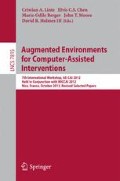Abstract
In spite of significant efforts to enhance guidance for catheter navigation, very little has been done to consider the changes that occur in the tissue during ablation as a means to provide feedback on therapy delivery. We propose a technique to visualize the lesion progression and monitor the RF energy delivery by means of a real-time thermal ablation model. The model is based on physical and physiological tissue parameters, and uses heat transfer principles to estimate temperature distribution and geometry of the generated lesion in real time. Validation of the model against experimental measurements recorded in ex vivo muscle samples ablated under clinically relevant conditions demonstrated good agreement between the predicted and measured parameters. We believe this technique will enable the generation of real-time thermal maps that can be used to guide the placement of successive lesions to ensure continuous and effective suppression of the arrhythmic pathway.
Access this chapter
Tax calculation will be finalised at checkout
Purchases are for personal use only
Preview
Unable to display preview. Download preview PDF.
References
Blaauw, Y., Crijns, H.J.: Atrial fibrillation: insights from clinical trials and novel treatment options. J. Intern. Med. 262, 593–614 (2007)
Pappone, C., et al.: Circumferential radiofrequency ablation of pulmonary vein ostia: A new anatomic approach for curing atrial fibrillation. Circulation 102, 2619–2628 (2000)
Oral, H., Pappone, C., et al.: Circumferential pulmonary vein ablation for chronic atrial fibrillation. N. Engl. J. Med. 354, 934–941 (2006)
Sra, J., Krum, D., et al.: Registration of 3D left atrial CT images with fluoroscopy. Heart Rhythm 2, 1020–1022 (2000)
Knecht, S., Skali, H., et al.: CT-fluoroscopy overlay evaluation during catheter ablation of left atrial arrhythmia. Europace 10, 931–938 (2008)
Dickfeld, T., Calkins, H., et al.: Stereotactic catheter navigation using magnetic resonance image integration in the human heart. Heart Rhythm 2, 413–415 (2005)
Rettmann, M.E., Holmes III, D.R., Cameron, B.M., Robb, R.A.: An event-driven distributed processing architecture for image-guided cardiac ablation therapy. Comput. Methods Programs Biomed. 95, 95–104 (2009)
Linte, C.A., Lang, P., Rettmann, M.E., Cho, D.S., Holmes III, D.R., Robb, R.A., Peters, T.M.: Accuracy considerations in image-guided cardiac interventions: experience and lessons learned. Int. J. Comput. Assist. Radiol. Surg. 7, 13–25 (2011)
Pennes, H.H.: Analysis of tissue and arterial blood temperatures in the resting human forearm. J. Appl. Physiol. 85, 5–34 (1998)
Duck, F.: Physical Properties of Tissues: A Comprehensive Reference Book, pp. 167–223. Academic Press, New York (1990)
Tungjitkusolmun, S., Staelin, S.T., et al.: 3D finite element analyses for RF hepatic tumor ablation. IEEE Trans. Biomed. Eng. 49, 3–9 (2002)
Chang, I.A., Nguyen, U.D.: Thermal modeling of lesion growth with RF ablation devices. Biomed. Eng. Online 3, 1–19 (2004)
Knowles, B.R., Caulfield, D., et al.: 3-D visualization of acute RF ablation lesions using mri for the simultaneous determination of the patterns of necrosis and edema. IEEE Trans. Biomed Eng. 57, 1467–1475 (2010)
Chan, R., Packer, D.: Accuracy of ICE measurement of RF ablation lesion dimensions in the intact canine atrium and ventricle. Circulation 92, I–794 (1995)
Rieder, C., Kroger, T., Schumann, C., Hahn, H.K.: GPU-based real-time approximation of the ablation zone for radiofrequency ablation. IEEE Trans. Vis Comput. Graph. 17, 1812–1821 (2011)
Author information
Authors and Affiliations
Editor information
Editors and Affiliations
Rights and permissions
Copyright information
© 2013 Springer-Verlag Berlin Heidelberg
About this paper
Cite this paper
Linte, C.A., Camp, J.J., Holmes, D.R., Rettmann, M.E., Robb, R.A. (2013). Modeling of Radiofrequency Ablation Lesions for Image-Guided Arrhythmia Therapy: A Preliminary ex vivo Demonstration. In: Linte, C.A., Chen, E.C.S., Berger, MO., Moore, J.T., Holmes, D.R. (eds) Augmented Environments for Computer-Assisted Interventions. AE-CAI 2012. Lecture Notes in Computer Science, vol 7815. Springer, Berlin, Heidelberg. https://doi.org/10.1007/978-3-642-38085-3_4
Download citation
DOI: https://doi.org/10.1007/978-3-642-38085-3_4
Publisher Name: Springer, Berlin, Heidelberg
Print ISBN: 978-3-642-38084-6
Online ISBN: 978-3-642-38085-3
eBook Packages: Computer ScienceComputer Science (R0)

